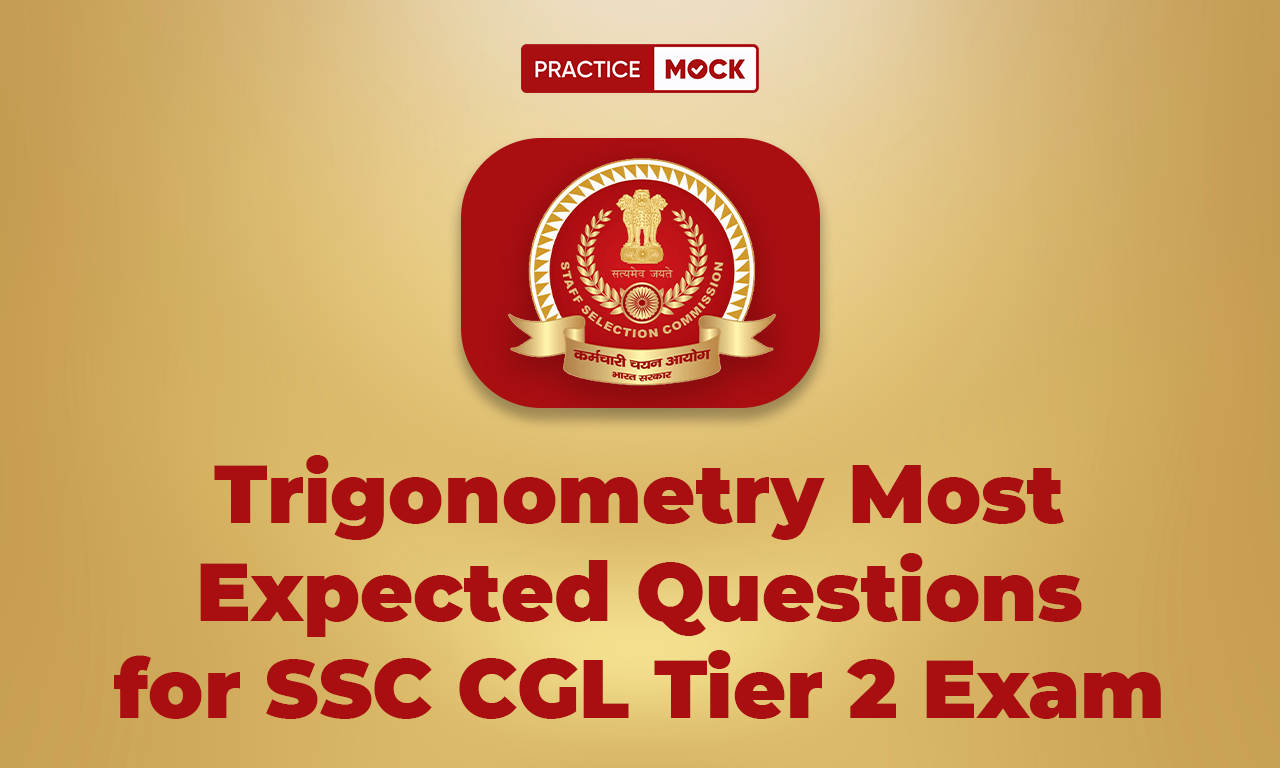Trigonometry for SSC CGL Exam: The Staff Selection Commission (SSC) conducts the SSC CGL exam every year. As per the selection process of 2024, the SSC has successfully conducted the SSC CGL Tier 1 exam. As the next step, the SSC will conduct the SSC CGL Tier 2 exam. Passing the Tier 2 exam is not an easy task. For the best preparation for the exam, candidates must prepare topic-wise to get a deep insight into the exam. In this blog, we have provided a basic concept about the trigonometry and most expected questions that can be asked in the SSC CGL Tier 2 exam. Trigonometry is a topic that belongs to the Quantitative Aptitude section in the Tier 2 exam. Candidates can expect at least 5-9 questions from this topic in the SSC CGL Tier 2 exam. Candidates who are going to appear in the exam must go through this blog carefully.
Concept of Trigonometry
Trigonometry is a topic of quantitative aptitude that deals with the relationships between the angles and sides of triangles, particularly right-angled triangles. The fundamental concept in trigonometry revolves around the ratios of the sides of a right-angled triangle relative to its angles.
Most Expected Important Questions PDF for Trigonometry
Question 1: What is the minimum value of 4(sin4θ + cos4θ – 2sin2θcos2θ)?
A) 1
B) 0
C) -1
D) 4
Question 2: When the altitude of the sun changes from 30° to 45°, the length of the shadow of an electricity pole on level ground decreases by 20 cm. What is the height of the electricity pole?
A) 8(√3 – 1) cm
B) 10(√3 – 1) cm
C) 5(√5 + 1) cm
D) 10(√3 + 1) cm
Question 3: If 3(sin2θ + cos2θ) = 4cos2θ, 0° < θ < 90°, the value of (tan2θ + cos2θ + sec2θ) is:
A) (10/7)
B) (15/19)
C) (29/12)
D) (30/13)
Question 4: The difference between the height of a pole and the length of its shadow is 4(√3 – 1) cm. If the height of the pole is 4√3 cm, then find the angle of elevation of the sun.
A) 60°
B) 45°
C) 30°
D) 90°
Question 5: The value of [sec(70°+ θ) – cosec(20°- θ) – cos264° – cos226°]/(sin32°cos58° + cos32°sin58°) is:
A) 0
B) -1
C) 1
D) 2
SSC CGL 2024 Tier 2 Free Preparation Resources
Below we are providing the SSC CGL 2024 Tier 2 Free Preparation Resources that contains multiple tests, including section-wise mock tests covering all the sections like English, General Awareness, Quantitative Aptitude, and Reasoning. Practicing these tests will help you revise all these sections in a time-bound manner and also test your skills and knowledge acquired in the last stretch of revision.
| SSC CGL 2024 Tier 2 Free Preparation Resources | ||
| Task 1 | SSC CGL 2024 Tier 2 Free Mock Test | Mini Mock Tests |
| Task 2 | Quantitative Aptitude Free Mock Tests | Sectional Mock Tests |
| Task 3 | English Free Mock Tests | Previous Year Question Paper |
| Task 4 | General Awareness Free Mock Tests | Mock Test 1 |
| Task 5 | Reasoning Free Mock Tests | Mock Test 2 |
| Other Blogs of SSC CGL 2024 | |
| SSC CGL Exam Pattern | SSC CGL Syllabus |
| SSC CGL Study Plan | SSC CGL Selection Process |
| SSC CGL Cut Off | SSC CGL Preparation Strategy |
| SSC CGL Previous Year Question Papers | |
Trigonometry Most Expected Questions for SSC CGL Tier 2 Exam FAQs
Trigonometry is a topic that deals with the relationships between the angles and sides of triangles, particularly right-angled triangles.
Candidates can expect at least 5-9 questions from this topic in the SSC CGL Tier 2 exam.
Candidates can expect the level of questions from this topic in the SSC CGL Tier 2 exam at a moderate level.
Candidates can find all the important formulas related to Trigonometry in this blog.
- Sign Up on Practicemock for Updated Current Affairs, Free Topic Tests and Free Mini Mocks
- Sign Up Here to Download Free Study Material
Free Mock Tests for the Upcoming Exams
- IBPS PO Free Mock Test
- RBI Grade B Free Mock Test
- IBPS SO Free Mock Test
- NABARD Grade A Free Mock Test
- SSC CGL Free Mock Test
- IBPS Clerk Free Mock Test
- IBPS RRB PO Free Mock Test
- IBPS RRB Clerk Free Mock Test
- RRB NTPC Free Mock Test
- SSC MTS Free Mock Test
- SSC Strenographer Free Mock Test
- GATE Mechanical Free Mock Test
- GATE Civil Free Mock Test
- RRB ALP Free Mock Test
- SSC CPO Free Mock Test
- AFCAT Free Mock Test
- SEBI Grade A Free Mock Test
- IFSCA Grade A Free Mock Test
- RRB JE Free Mock Test
- Free Banking Live Test
- Free SSC Live Test



